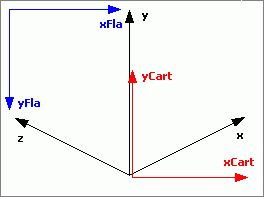Since there aren't many good tutorials online for
creating isometric games, I encountered many problems
while making my
isometric game. Since I am a nice guy, I'd like to share
some tips and tricks that I learned, and I hope that they will
be inspiring to other Flash developers such as yourself.
These tutorials are all about isometry, or,
more
specifically, about creating a "filmation" isometric game
similar to
Knight
Lore.
 |
Note |
|
These tutorials can be used for programming an
isometric game in many programming languages not
just in Flash. They are more about game
programming than about Flash programming. |
|
Some of the tutorials that I hope to write in the future will
expand upon what I cover today with isometric drawing, hit tests, push-flags,
walls and doors handling, maps, depth sorting (which I found to
be the hardest part) and all kinds of related stuff.
But, we are getting a little ahead of ourselves. Let's learn
about isometric transformations first!
Static
isometry
I have to point out that
Senocular's tutorials are excellent for the introduction to
isometry and it's problems, but there are many things that
cannot be done by using this (as I call it) "static isometry"
approach.
With "static isometry" I assume that the majority of the
objects are "fixed" to the floor, meaning they cannot be moved.
Their levels cannot be changed - depth sorting is done by
changing the level of the main character only.
Dynamic isometry
Dynamic isometry assumes the following rules:
- Objects are not fixed to the floor, thus their positions
cannot be contained in an array.
- All of the objects in the room can be pushed and moved.
- Hit tests are done by comparing every object's position
with all other objects through the loop.
- Depth sorting of objects has to be made dynamically -
the level of every object has to be changeable.
The Facts
I'd like to
start out with two facts which seems are not so obvious to
everyone.
 |
Fact Number 1
|
|
All
things (calculations etc.) have to be done in 3d
coordinate system, and then transformed into 2d
using isometric transformations. |
|
I've seen some
attempts
of trying to use Flash's hitTest
function to detect collisions in isometry. But, as I said - they
are only attempts, because of rule number 2:
 |
Fact Number 2
|
|
Collision detection in isometric projection
cannot be done using
hitTest
function. |
|
The reason you can't use collision detection with hitTest, is that
the hitTest
function is capable only of calculating 2d, rather than 3d
collisions. So we'll have to come up with some other method.
But first, let's take a look at the coordinate systems we will be
using.
Coordinate systems and
transformations
We have 3 coordinate systems involved in isometric
transformation equations:

[ isometric,
cartesian and flash coordinate system ]
An isometric coordinate system in the above image is colored black. The red one
is cartesian, and a blue one is Flash coordinate system (which
has an offset and reversed Y axis).
The functions for transforming 3d into 2d are:
- // transforms x,y,z coordinates into
Flash x coordinate
- xFla =
function
(x,
y, z)
{
- // cartesian coordinates
- xCart
= (x-z)*Math.cos(0.46365);
- // flash coordinates
- xI
= xCart+xOrigin;
- return
(xI);
- };
-
- // transforms x,y,z coordinates into
Flash y coordinate
- yFla =
function
(x,
y, z)
{
- // cartesian coordinates
- yCart
= y+(x+z)*Math.sin(0.46365);
- // flash coordinates
- yI
= -yCart+yOrigin;
- return
(yI);
- };
A few words about these functions:
0.46365 (radians) - it's a
“classic” 1:2 isometric angle which lays up perfectly into pixel
grid of the computer screen.
 |
Note |
|
1:2
means that you draw a line moving two pixels
right and one pixel up.
It slightly differs from a 30º isometric
coordinate system, because it is an
arctan(1/2), which is actually
a 26.57º angle. |
|
xOrigin, yOrigin – offset of
isometric and cartesian origins in a Flash coordinate system.
x, y, z – isometric coordinates
(black axis in the figure above)
xCart, yCart – cartesian coordinates
xFla, yFla – Flash 2d coordinates
 |
Note |
|
It
is possible to translate coordinates from 3d to
2d only. The other direction doesn’t work
because there is a third parameter missing! |
|